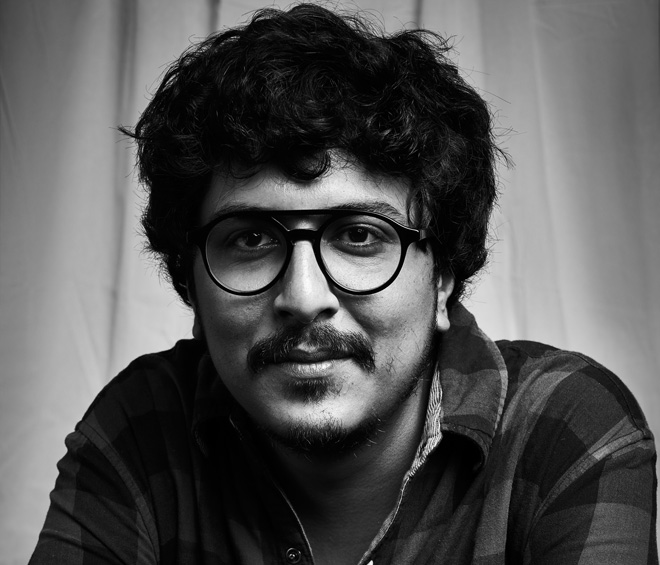
by SKYE ARUNDHATI THOMAS
Photographer Ronny Sen meets the coalfields of Jharia, in the eastern Indian state of Jharkhand, with the blunt, oblique lens of his camera. In images from the series Fire Continuum (2014), an apricot-orange fire leaps from the ground in single, swift gusts. It hovers above the ground, as though without a source, like an angry spectral being: brightly hot and spitting through the dirt. Sen follows the fire across rocky fields and clean-cut valleys. He photographs it at twilight, when the light fills the sky like in shifting hues of purple and blue. He photographs the explosions by daylight: in Jharia End of Time 11 (2014), a plume of grey and brown smoke curls into the sky, while a patch of dried grass uncannily matches its colours.
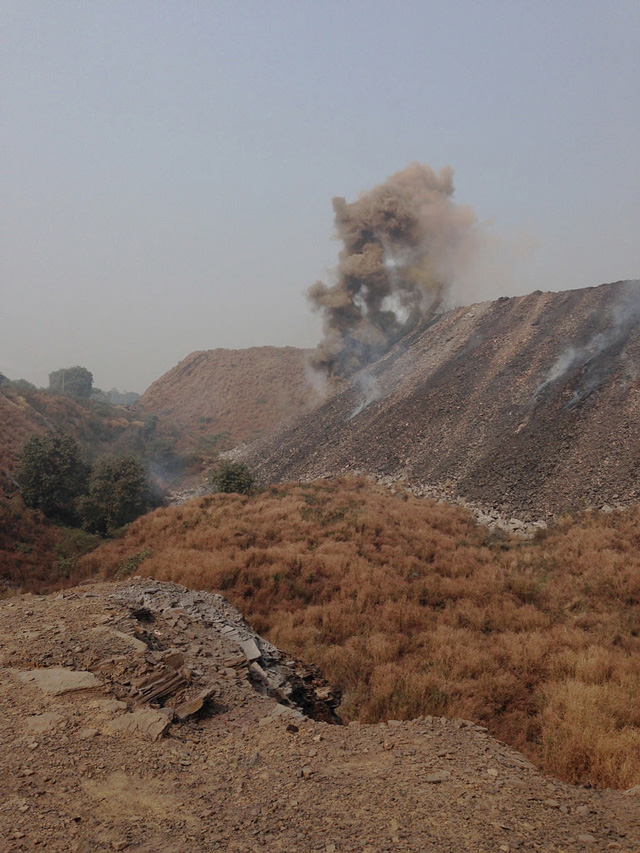
Ronny Sen. Jharia End of Time 11, 2014. Archival pigment print, 9 x 6.75 in. Courtesy Ronny Sen and TARQ. Copyright Ronny Sen 2014.
Coal deposits are flat and layered: layers of coal are interspersed with layers of dirt. With opencast mining, explosives are used to blast open the deposits, exposing the coal. But exposed coal has a tendency to spontaneously combust, as the minerals on its surface oxidise very quickly, resulting in brutal freak accidents: fires that burn for decades and are impossible to extinguish. The layers of dirt hold the fires, which burrow deep underground, spreading wildly, hunting for more coal. In the coalfields of Jharia, one such fire has been burning since 1916. Here, the flames sometimes go as high as 18 metres (60ft). Mining first began in Jharia in the late 19th century under the British Empire, was picked up again under the Nehruvian Nation Building Project of the 1950s, and then, a couple of decades later, by Coal India, which nationalised the country’s collieries. The underground fire there is one of many that burn all over the world, forcing indigenous populations to turn nomadic: either following the fires to stay close to the coal as a source of income, or hastily packing up under the threat of incineration by an unexpected burst of fire.
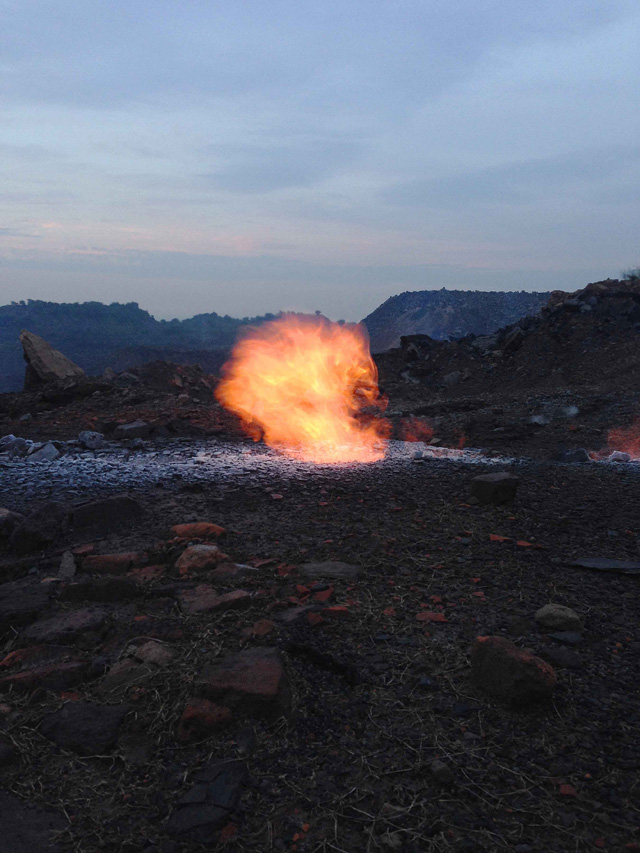
Ronny Sen. Jharia End of Time 13, 2014. Archival pigment print, 9 x 6.75 in. Courtesy Ronny Sen and TARQ. Copyright Ronny Sen 2014.
What makes Sen’s work particularly gripping is that the landscape melts into itself: colours bleed into each other, confusing definition. It is never clear what the source of the fire is, or what is land and what is air. Sen also assembles a cast of protagonists: the endlessly hard, stony terrain; a white Ambassador car parked on a cliff; a miner covered in sparkling soot, posing begrudgingly – but confidently – for the camera; something grey, like liquid cement, haemorrhaging out of the earth and into rocky puddles. Fire Continuum was most recently shown at Tarq, Mumbai, towards the end of last year, in the show of the same title. Here, Sen took viewers to Jharia with a moody poetic, forcing them to focus on each image, which is always a small print.
Sen was born in 1986 in Silchar, Assam, in the north-east of India. His family migrated to Calcutta (now Kolkata), West Bengal, in the early 90s, and he continues to live and work there. In 2016, his photographs of Jharia won the Getty Images Instagram Grant, and were exhibited in the Netherlands and in New York. He has published the work under the title End of Time (2017) with Nazar Monographs. Sen is also a film-maker; his first feature film, Cat Sticks (2019), received an honourable mention at the Grand Jury Prize for Best Narrative Feature at this year’s Slamdance Film Festival. The film follows a group of addicts in Kolkata as a relentless monsoon downpour engulfs the scene. “As globalisation and neo-liberalism turn the urban landscape into an odd mix of exhausted tradition and hurried modernisation, we stare at the city’s underbelly,” he writes in a note about the film. “Failing matchsticks punctuate the soggy pits of this wet night.” Sen’s work often takes on a grim view: identifying strongly with those who are ostracised by urban life.
-2014-Archival-Pigment-Print.jpg)
Ronny Sen. Jharia End of Time 2(C), 2014. Archival pigment print, 9 x 6.75 in. Courtesy Ronny Sen and TARQ. Copyright Ronny Sen 2014.
Sen and I first met at Tarq, a few weeks after his show was installed. We smoked cigarettes in the garage of the old Deco complex, Dhanraj Mahal, where the gallery is located. It was just after the monsoon, and the bright pink bougainvillea creepers were bursting with flowers, scattering them across the floor. It was a dramatically different landscape from the one that Sen and I spoke about. His was a world of coalfields and never-ending fires; a dry, scorching heat. But here we were in the lap of pristine old Bombay: terrazzo tiles and manicured gardens. Still, we agreed on a similarity: the only nature left was that which we had to steal from the margins of urban life.
Skye Arundhati Thomas: Your photographs of the mines and the people of Jharia are theatrical and full of narrative, but you also treat the landscape with a careful, formal attention. I am interested in where the two meet. How did you develop this particular formalism?
Ronny Sen: In Jharia, I could never return to the same spot to take the same picture again. The fire pushes against the landscape. I first travelled there in 2014. Two French film-makers were working on a film for France 5 TV and I was hired as fixer, producer and translator. I had no plans to photograph; I didn't even take a camera with me. I had heard about Jharia and about the fire, mostly from the media because photojournalists have been going there for a very long time. But the moment I landed in Jharia, it was unlike anything I had ever seen before, or anything I expected – there was a fire pouring right out from the earth, moving the landscape around every single day.
I began to use my phone camera to shoot, interested by the vertical format as an approach towards landscape, rather than horizontal, as the old masters have always done. It became an interesting exercise to watch this strange, changing topography through my narrow phone. After three weeks, I developed a discipline in my work: I would maintain a certain distance and position what I photographed at the centre of my frame. I was taking more than 300 photographs a day and, eventually, I had more than 12,000. It took me four years to edit them: I brought 12,000 images down to 40. I wanted to say things with brevity.
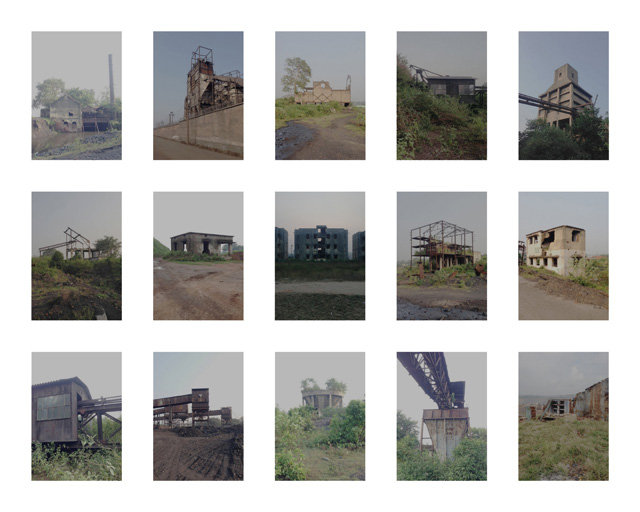
Ronny Sen. Untitled III, 2014. Archival pigment print, 9 x 6.75 in. Courtesy Ronny Sen and TARQ. Copyright Ronny Sen 2014.
When I display or show the series, they are always very small prints. A small print draws the viewer close to the surface of the image. It seemed to me that the only way to negotiate this narrative was with subtlety and a certain quietness: where the smoke coming out of the fire in one image may merge in with the smoke in the next image, which may be the result of a completely different source. I played with a certain abstraction, because I didn’t want to reveal everything at once. I didn’t want to be completely mysterious either, so every image has something it reveals and something it hides.
SAT: You approach your subject quite literally, and I appreciate that. It makes me think about Amitav Ghosh’s argument in his book The Great Derangement: that it is difficult for the contemporary imagination to grasp the present realities of climate change because we are constantly relegating geo-catastrophe to metaphor or allegory. In response to this, a literal approach can be a useful one. Maybe one of the things we can do to no longer speak in metaphors is just to present the evidence, as you do.
RS: They are definitely literal, but they are also very difficult to place. For my show Fire Continuum at Tarq, Mumbai, in August 2018, we had no captions under the photographs to explain what they were, or where they were from. I wanted viewers to come to the images and come up with their own meanings and stories. People have told me that this is cynical work, that it is a tragedy. But this work is not only about the environment: it is also about human life; it is about the economic and political problems that are faced not only by the people of Jharia, but those across the world. In Jharia, it may be about coal, while in a West African country it is about diamonds, and, in the future, it will be about water all over the world.
-2014-Archival-Pigment-Print.jpg)
Ronny Sen. Jharia End of Time 2(B), 2014. Archival pigment print, 9 x 6.75 in. Courtesy Ronny Sen and TARQ. Copyright Ronny Sen 2014.
It is also important to be literal because metaphors or symbols often change their meaning with time. In the 1960s, Raghubir Singh famously photographed India using a white Fiat Ambassador car – he drove across the country in the Ambassador and photographed through its windows and mirrors – and for him, the car was a symbol of Indian modernity. But to me, since I was a child, I always have seen the white Ambassador as a symbol of Indian bureaucracy and cronyism. Ironically, its status completely changed in just a decade: it went from being a symbol of progress to something that impedes it. The white Ambassador is now so far from any notion of modernity. For instance, when the scavengers of Jharia see the white Ambassador, they know a bureaucrat or a mine official has come to their area and that they have to run away. It’s a terrifying sight to them.
Like the Ambassador car, Coal India was also a legacy of the Nehruvian Nation Building project. For me, where the Nehruvian dream is concerned, it has failed. And now the future, too, fails the imagination: the work is about the apocalypse in a certain way, where everything will go to the fire and the dust.
SAT: What is your editing process like? Bringing down 12,000 images to 40 does not sound easy. What were you looking for?
RS: In most of the images, the point of interest is kept in the middle. I want to take the viewer’s eye straight to the middle of the image. Every image has a certain energy, so the moment you put three images together you have a rhythm, a pace. This pace is intentionally quite slow, and a little grim. I also wanted to make it circular – where the viewer’s eyes rotate all around the image, and across all of the images next to it in on the wall. At the same time, I try to float in the individual energy of each image so that you keep looking at one image for some time, and the moment you look at another image, you want to look at both the images together, and for a while. The logic of the edit was to hold the viewer for as long as possible.
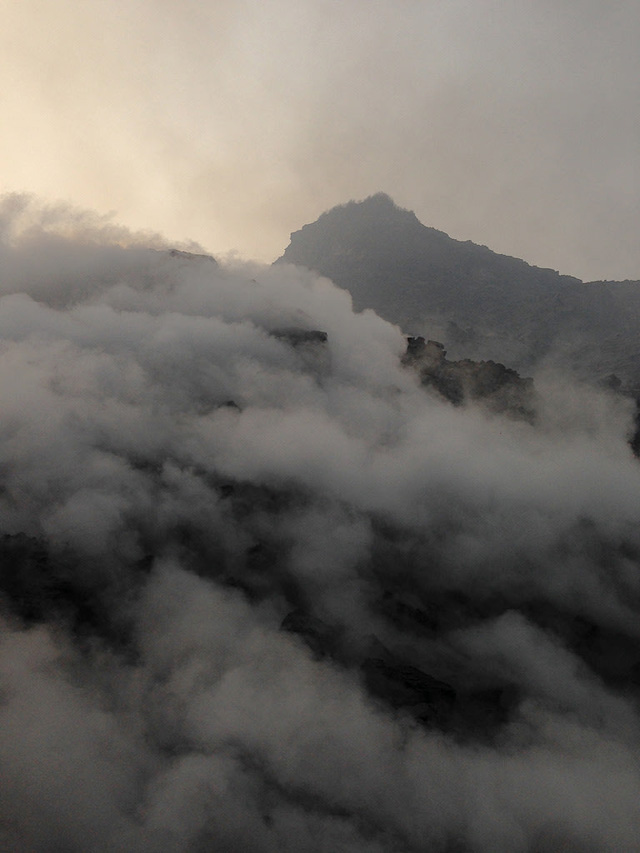
Ronny Sen. Jharia End of Time 3, 2014. Archival pigment print, 9 x 6.75 in. Courtesy Ronny Sen and TARQ. Copyright Ronny Sen 2014.
It’s about creating a journey: there is smoke drifting over a village and maybe it’s coming from a house, and there is a certain shape to the smoke that is, say, cutting across the left side of the frame, and you look at the image next to it and there’s smoke there too, and in exactly the same shape, but you don’t know where it’s coming from. This makes you want to look at the image more, and make associations with other images, and you want to ask more questions. There is some plastic material on the ground – what is it? It might be dynamite. There is smoke coming from below – is it because of the fire? Is it because people are trying to control the fire? Will there be another blast?
SAT: Having pace, rhythm and unexpected twists sounds like a very cinematic approach. Is this the purposeful handling of photography as cinema?
RS: I want to give a certain experience of something I have witnessed, and give meaning to my experience. And, yes, to keep this as cinematic as possible. A photographer can guide the viewer to think in a certain way in the same way that a director can with cinema. But this requires us to move away from the idea of the single image. Old-school documentary photographers bring it down to a sort of basic narrative, mediated by single, powerful images, but in Jharia there is no straight narrative. I guess what I am trying to say is that I am not interested in giving the viewer a point of entry. The only points of entry I give are the fire and the blasting. But these are only two points of entry. The rest, I have tried to mystify as much as possible.
SAT: I like the idea of taking the viewer on a journey of something you have experienced, but orchestrating it in a very specific way. And, more importantly, doing it without producing simple narratives. So, here the fire is just one point of entry – not the entire point. This is something I rarely see conventional forms of photojournalism do, particularly when South Asia is photographed by a western lens. It often feels as if complexity and nuance are flattened and simplified to suit these simple narrative objectives.
RS: I think it’s because documentary photographers try to work with that they see; they don’t try to work with what they know. In Jharia, I’m not just shooting what I see, I am also shooting what I know. For decades now, photographers have gone there just for a week or so, and photographed what they see. I am trying to photograph what I know, and, in that process, I am also evolving. What I know today is different from what I will know tomorrow. My knowing is dependent on self-critique and on a challenging of my position. It is important for me to constantly critique how I represent – and interact with –people who have been oppressed for centuries, as they have in Jharia.
Why am I doing it? In Jharia, people have no option but to cope with the fire. They are totally dependent on the mines. Even if there is a blasting every day, people move with the mines. Communities that depend on the mines follow the fire and smoke because that is the only way that they earn, and that is the only way they can survive. These are all people who have been historically exploited: first by the maharajas of Jharia, then the British, then the government of India. Even where the communists came with their different labour unions, they were still exploited. It’s a story of historic oppression and exploitation. When Coal India tried to control the fire, it blasted open the soil further, and tried to dig out all the burning coal. But it could never stop the fire, and steadily it was lit underneath all of Jharia. The fire burns under every house, every mosque, every church and every temple.
-2014-Archival-Pigment-Print.jpg)
Ronny Sen. Jharia End of Time 5(B), 2014. Archival pigment print, 9 x 6.75 in. Courtesy Ronny Sen and TARQ. Copyright Ronny Sen 2014.
The image Jharia End of Time 5(B) (2014) is of a broken orange wall, a hillock and a little water underneath. It’s actually the wall of a Hindu temple, but, if you look closely, you see that the wall merges with the hill. The two overlap, they mix. Maybe you don’t fully understand why this wall is merging with the ground behind it. So there is an abstraction, but there is also confusion. To a certain extent, I am forcing images to hide things. What I want is for the viewer to work with me. I don’t want to give things away easily.
SAT: I really appreciate the notion of photographing or working with what you know rather than just what you see. Perhaps this is a nice segue to your film, Cat Sticks (2019), which stalks through Kolkata, a city you know well, having spent a large part of your life there.
RS: Calcutta, as it is still called by many, was once a great city, but, to me, now it feels dead. This is what I know, and that is the role I have to play here: to talk about how great cities die. Every city has its own time, its own euphoria, where it is at its peak of political and cultural activity, like Calcutta was maybe in the 60s and the 70s. But not any more. There is no economic activity, there is no political activity and there is no cultural activity. The city is kind of rotting, and all its talent keeps leaving it, either for Bombay or for Delhi. We are, instead, plagued with IT professionals trying to make money, and to spend the same money in different outlets and shopping malls.
I want the film to talk about the city in a way that it is – and not what is embedded in the minds of the nostalgic Bengali. It is easy to construct a narrative of that romanticism: that Calcutta is Howrah Bridge or Satyajit Ray or Rabindranath Tagore. My Calcutta is in the people that occupy and own the streets of Calcutta on a rainy night: the junkies, the drug dealers, the middlemen.
SAT: The death you speak of might just be of one narrative, or of one reading of the city. Perhaps now the city is evolving into a new iteration. Although I see what you mean, it’s a common anxiety in the subcontinent, as many of us stare down the logical end of urbanism, which has taken the loss of history as its collateral.
RS: My father came from Silchar to Calcutta in search of social mobility, but now all my friends leave the city to look for this elsewhere. This is fundamental to me. I might be wrong, I might be being very emotional, but I feel that we are all, collectively, loosing something essential: our political consciousness is dying and our cultural consciousness is dying, too. But when I say that we are a dying city, I say this with great responsibility –there is no sadness there, there is a desire to make work from it and to shoulder its representation.